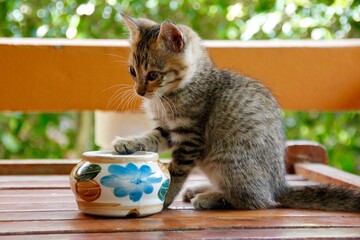What are some examples of living things?

A cat is a living being.

A cat is a living being.
There are many examples of living things around us. Living things are all around us and they can be found in our homes, backyards, and even in the sky. Plants, animals, insects, birds, and humans are all living things. But, what makes them living?
Living things are characterized by a set of unique features that differentiate them from non-living things. One of the most important characteristics is that living things can grow and develop. A tiny seed can grow into a big tree, and a baby goes through many stages to grow into an adult.
Plants are living things that grow from seeds. We can see them in parks or even in our backyard. They need water, soil, and sunlight to survive. Trees, flowers, grass, and vegetables are all examples of plants. They are important because they produce oxygen that we breathe.
Animals are also living things. Dogs, cats, fish, and birds are all animals. They can move by themselves and respond to their surroundings. Some animals are domesticated, which means that they are adapted to live with humans, while others live in the wild.
Insects are another example of living things that we can find around us. Butterflies, bees, and ants are all insects. They have six legs, wings, and can fly. They are important for pollinating flowers and keeping our ecosystem in balance.
In conclusion, living things are all around us and they come in many shapes and sizes. Plants, animals, insects, and humans are all examples of living things that we can see in our everyday life. They all have specific characteristics that make them unique and important for our ecosystem.
How do living things obtain energy?
Living things obtain energy in different ways. Some animals, like lions and tigers, get their energy by hunting and eating other animals. They are called carnivores. Other animals, like cows and deer, get their energy from eating plants. They are called herbivores. Some animals, like humans, eat both plants and animals and are called omnivores. Plants get their energy from the sun through a process called photosynthesis. They use sunlight, water, and carbon dioxide to make their own food. So, different living things have different ways of getting their energy.
What are some adaptations that help living things survive in their environment?
Living things have special characteristics called adaptations that help them survive in their environment. For example, a polar bear has a thick layer of fat and fur to keep them warm in the cold Arctic. This adaptation helps them survive in their icy habitat. Another example is the long neck of a giraffe, which helps them reach leaves on tall trees for food. The long neck is their adaptation for survival in their savannah habitat.
What are the different types of interactions between organisms?
Organisms in nature interact with each other in different ways. Here are a few examples of these interactions:
- Mutualism: when both organisms benefit from their interaction. For instance, bees collect nectar from flowers and help spread their pollen, while getting food for themselves.
- Predation: when one organism hunts and eats another for food. A lion hunting and eating a zebra is an example of predation.
- Competition: when organisms compete for the same resources, such as food, water, or territory. Two birds fighting over a worm is an example of competition.

A cat is a living being.